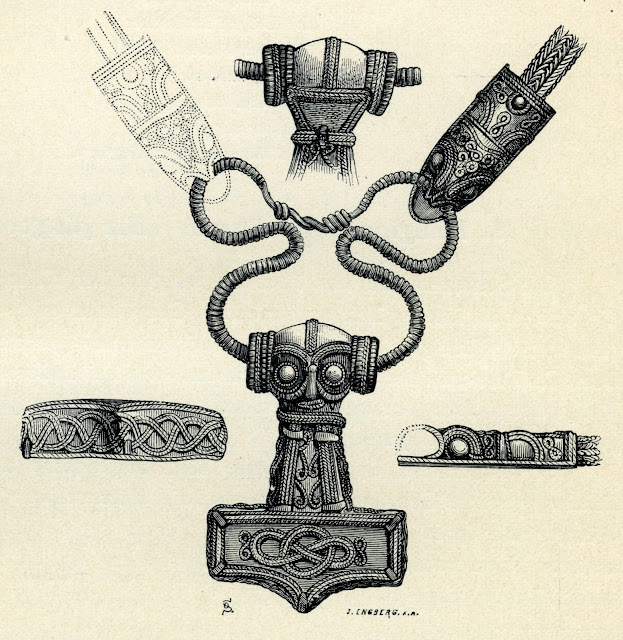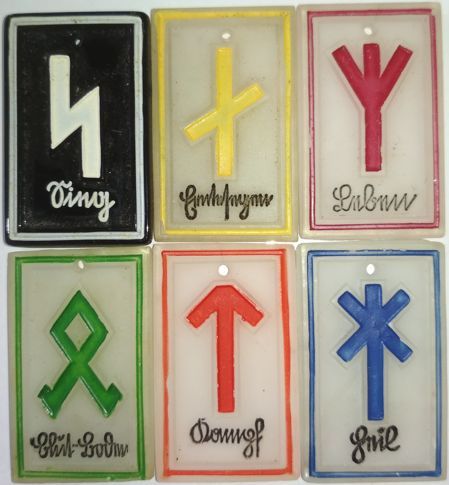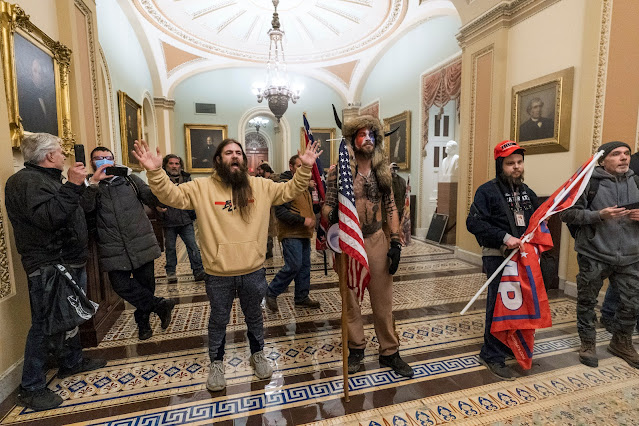 |
| “QAnon Shaman” during the Capitol attack on January 6, 2021 (Manuel Balce Ceneta photo) |
A common theme in reporting on the event and the American Heathen reaction was the assertion that “the Heathen community” is standing against “appropriation of their symbols by white supremacists and extremists.” Heathens themselves accused the Capitol attackers of taking “our symbols” and described them as “extremists on the lunatic fringe of the far right.”
In interviews and comments, American Heathens stated that “white supremacy is the antithesis of [their] beliefs.” They denounced “fringe right wingers appropriating Heathen iconography” and placing their “articles of faith at the center of the violence.” Reports referred to “the reactions of REAL HEATHENS on the appropriation of their symbols,” and reporters stated that the “appropriation infuriates contemporary pagans and Heathens.”
The attack on the Capitol was indeed a shameful assault on this nation’s democratic process and democratically elected officials. Racist iterations of Ásatrú and Heathenry are indeed abominations that have documented connections to hate speech and hate crimes. There is no question that Heathens who stand against racism and racist violence are right to speak out and clearly voice their strong opposition.
There are fundamental issues, however, with the repeated claims of appropriation.
Basic definitions
James O. Young, Professor of Philosophy at University of Victoria, defines “cultural appropriation” as an act “that occurs across the boundaries of cultures. Members of one culture (I will call them outsiders) take for their own, or for their own use, items produced by a member or members of another culture (call them insiders).” The in-group creates cultural goods both material and immaterial, and the out-group breaches the separation between the two groups to take these goods and use them – or even claim that they themselves are the true creators and owners.
Issues of power differential are key to cultural appropriation. Raymond Yang, a visual art teacher in Seattle who writes about approaches to teaching the concept to students, defines the term as “the adoption of the elements of another culture (often a minority group) by members of the dominant culture. It is an unequal exchange in that the appropriators often use these stolen elements for monetary gain or prestige, without regard for the value, respect, or importance paid to these images and traditions in the original culture.” It is the inequality between different cultures that spurs and enables the appropriative act, as the larger, more powerful group takes and claims ownership of the cultural material belonging to the smaller, less powerful group.
Ann Rosalind Jones and Peter Stallybrass, both professors of comparative literature, connect cultural appropriation to European colonialism. They write of unequal exchanges in which “the colonizing powers” take “appropriated goods” from Africa, America, and Asia while valorizing the “supposed heroism” of the takers and erasing the labor of the producers. Again, the stress is on the crossing of cultural boundaries, as the powerful outsider not only removes the cultural materials, but claims them as their own and negates the creative act of the insider.
Reviewing the Heathen claims of cultural appropriation in light of these definitions and explanations, it quickly becomes clear that there are some basic contradictions.
Creation
The designation of an act as “cultural appropriation” presupposes that the in-group whose cultural goods are being appropriated created those goods. In the case at hand, this presupposition has no basis in historical fact.
As portrayed on the lower torso of the tattooed Capitol rioter, Thor’s hammer is in the general shape of the small pendants that saw a surge of popularity in Scandinavia during the era of Christian conversion a millennium and more ago. Simpler versions of the hammer appear on memorial stones and in depictions of Thor from the Viking Age. In Sweden, primeval predecessors of the god’s hammer in the form of an axe wielded by a godlike figure are found in carvings dating to approximately 1800 BCE.
The three interlocking triangles sometimes called Valknut today are clearly represented on a finger-ring dating to the 700s or 800s and found in Cambridgeshire, England. They also appear on a handful of Scandinavian items of the Viking Age, most notably a stone carving from the 700s in Gotland, Sweden. The association of the symbol with the Norse god Odin, writes Christopher Abram of University of Notre Dame Medieval Institute, is simply down to the fact that “it tends to accompany pictures of warriors.”
 |
| Finger-ring from 8th-9th century found in Cambridgeshire, England (British Museum) |
Yggdrasill, the World Tree of Norse mythology, appears in the Old Icelandic mythological poems and Snorri Sturluson’s Edda of c. 1220. There have long been theories forwarded that attempt to connect various medieval descriptions and representations of trees and other objects to Yggdrasill as described in the literary sources, but images of the tree used by Heathens today – and in the tattoos of the Capitol attacker – seem to be based on either illustrations from the 1800s and 1900s or on original art from the wider modern Pagan sphere.
Aside from copyright issues relating to specific modern interpretations by individual living artists, there can be no claim of creation by American Heathens of the symbols of hammer, triangles, and tree that are historically related to Old Norse mythology and religion in one form or another. Even the most casual perusal of archaeological and literary attestations shows the ancient nature of these symbols, as it does of religious symbols from around the world.
The American Heathens now speaking out are not claiming creation, but the act of creation is fundamental to the very notion of cultural appropriation. Without it, the claim is built on quicksand.
Ownership
A group can claim legitimate ownership of a cultural good even when it was anonymously created long ago, if it was subsequently reproduced and used over many centuries. This continued reproduction and usage over the long term – especially when intrinsically connected to religio-cultural practices – can form the rightful basis for righteous claims of appropriation.
Unlike the claim of creation, the claim of ownership of the hammer, triangle, and tree symbols is specifically being claimed by the American Heathens and clearly attributed to them by reporters. Like creation, this has no basis in historical fact.
When I asked Uppsala University Professor of Scandinavian Languages Henrik Williams who owns these three symbols, he simply replied, “Nobody and everyone.”
Helga Hlaðgerður Lúthersdóttir, Lecturer (Teaching) in Icelandic at University College London, likewise said that the symbols are owned by “no one,” and explained some of the elements in play:
This is a cultural heritage, but even so something that is very much a thing of the past and in no way alive in Nordic cultures today. Where these symbols have gained new lives is in congregations and kindreds of neo-Pagans, and there, symbols such as the Thor’s hammer have absolutely new importance, a religious importance, similar to the Christian cross. But this is not a cultural heritage, and I have never been able to accept arguments to that direction.
She specifically addressed the enormity of the gulf between the Old Norse religion and American Heathenry.
With the massive gap we have between the source culture, the Norse, and the target culture, the contemporary white American, there is absolutely no way anyone can claim an unbroken line and, thereby, “ownership” of any of those cultural components. Whether we are looking at claims to Viking heritage or pagan heritage, we are looking at a recreation or reestablishment of a culture that not only firmly and squarely belongs in the past, but which came to an end. Certainly, certain cultural elements survived the conversion to Christianity and the shift to (near) feudal agricultural society under church and king, but they did not do so as remnants or beacons of glorious past, but rather as folkloristic reactions to work and environment.
An item like the Thor’s hammer found in Denmark is likely to have meaning to a Dane as something that refers to their ancient history. But the meaning of it as a religious item has been broken long since, and any such meaning attached has been recreated. This meaning can absolutely be true to the believer, but it is not a meaning the culture has carried on, but a culture that has been re-established through scholarly and cultural work.
 |
| Illustration of Thor’s hammer pendant from Östergötland Sweden Kulturgeschichte Schwedens von den ältesten Zeiten bis zum elften Jahrhundert nach Christus by Oscar Montelius (1906) |
The leaders of Iceland’s Ásatrúarfélagið (“Ásatrú Fellowship”) have long taken a strong stand against racism, including in a 2014 statement particularly rejecting “the use of Ásatrú as a justification for supremacy ideology.” The statement also recommitted to welcoming foreign visitors “with an interest in our cultural heritage and spiritual traditions.” But any American Heathens – even the self-declared “not racist” ones – claiming the symbols as their own and accusing others of appropriating their cultural property gets a strong reaction in Iceland.
Jóhanna G. Harðardóttir, currently serving as the Icelandic organization’s allsherjargoði (roughly “high priest”) while Hilmar Örn Hilmarsson is on leave, resolutely rejected any American Heathen claim to ownership of the symbols. “In my eyes, these ‘non-racist groups’ are in their own minds some kind of mentors of a culture they don’t know and is not their own – something they just don’t understand and never will,” she told me. “For me, this is like looking at children in the playground fighting over whose sand it is they are throwing into each other’s eyes.”
Separate and unequal
In addition to issues of creation and ownership, the concept of cultural appropriation foregrounds (a) unequal exchange between separate cultural groups in which (b) the larger and more powerful group takes cultural goods from the smaller and less powerful group and (c) claims the goods as their own while erasing the claim of the first owners. Statements on appropriation from American Heathens in media accounts after January 6th fail on all three counts.
Overtly racist American Heathens do not belong to a culture that is separate from that of those making the claims of appropriation against them. American Heathenry today encompasses a range from white supremacist to antifascist activist, with practitioners found at multiple stops between the two extremes on right and left. Since the beginning of American Ásatrú in the 1970s – and especially after its splintering in the 1980s – there has been a porous border between the overtly racist and not-overtly-racist factions, with practitioners, clergy, authors, and leaders moving from one side to the other at various points.
This lateral movement within the subcultural milieu of American Heathenry has been long documented by academics such as Jeffrey Kaplan in religious studies and Mattias Gardell in comparative religion. It can be seen as an ongoing process in expulsions of elders, exchanges of authors, and swaps of publishing rights. Scholars tracing the history of the various warring factions over time find those who lead one side writing articles and rituals for the other. With such intertwined roots and growth, the element of unequal exchange between separate cultural groups is simply absent.
The point regarding the larger and more powerful group taking cultural goods from the smaller and less powerful group is also vexed in this case. If those accused of appropriating the symbols belonging to “not racist” American Heathens are “extremists on the lunatic fringe of the far right” and “fringe right wingers appropriating Heathen iconography,” as is claimed in the media reports cited above, the racists are then a smaller, less powerful group taking the symbols of a larger, more powerful American Heathen group that opposes them. This claim that the appropriators are members of a small “fringe” puts the concept of cultural appropriation as a power imbalance on its head and knocks out this element of the term’s definitions.
The claim doesn’t work even when reversed. If the racists are a smaller group, then the claim of appropriation doesn’t work; if the racists are a larger group, then the claims that they are merely a fringe is false. It has been quite difficult to find out where the largest numbers of American Heathens actually do fall on the left-right spectrum, with numbers of active participants in various organizations difficult to verify, with an unknown number of solitary practitioners, with the high amount of turnover in this relatively small new religious movement, and with the general problem of taking claims of “I’m not racist” from white Americans at face value. In any case, it doesn’t really work to simultaneously claim to be both the righteous majority and the victimized minority.
The element of the dominant group claiming given cultural goods as their own while erasing claims of the first owners not only bumps up against unfounded assertions of ownership but also inverts the history of American Heathenry. The overtly racist, neo-völkisch version of Heathenry was here in the United States growing its numbers for nearly two decades before any significant “not racist” form appeared. Indeed, the branch of American Heathenry that declared itself to not be solely centered on völkisch ideology split off from the racist version during the mid-1980s schism mentioned above.
 |
| Glass rune pendants issued in Germany by the Nazi Deutsche Jugendherbergswerk (1940) |
After the split, not only were individuals and writings able to move freely between the various branches that grew from a common racist trunk, but “not racist” practitioners did and do use concepts either created by the first, völkisch American Heathens or imported by them from 19th century Romantic nationalists, German völkisch mytics who influenced the Nazis, and actual Third Reich occultists. There remains to be written a detailed academic study of today’s American Heathen theology and practice that carefully parses the origins of each individual strand.
Perhaps this part of the argument is off-topic, and the American Heathens making claims of cultural appropriation are only and specifically talking about non-Heathen racists. The problem with this idea is that we have seen denunciations and accusations using the same language whenever a racist or neo-völkisch Heathen individual or organization makes an offensive statement or is in the news for hate speech or hate crimes. In those cases, the racist Heathens are often said to be “not actually Heathens” – as echoed in the statement about “real Heathens” cited at the beginning of this article.
In addition to veering into a “no true Scotsman” fallacy, this idea of “not actually Heathens” also touches on the fallacy of equivocation. When the social media accounts of someone like the tattooed Capitol rioter use images and texts from non-Norse mythologies and religions in addition to ones associated with Heathenry, American Heathens says this means he is “not Heathen.” Yet it is not uncommon for American Heathens to include veneration of deities and mythological figures outside of the “Norse pantheon” in their practice, nor is it uncommon to incorporate elements of worship taken from other traditions. Generally, these individuals are not publicly branded “not Heathen,” but are instead described with terms such as “dual trad[ition]” or “honoring the gods of their ancestors.”
Making the claim
When American Heathens make claims of appropriation, are they themselves engaging in appropriation of a term used to elucidate ways in which white Americans have appropriated cultural goods from BIPOC (black, indigenous, and people of color) communities here and around the world? I asked a variety of scholars what they thought of this complicated situation.
Yolanda Martinez-San Miguel, Professor in the Department of Modern Languages and Literatures and Chair of Latin American Studies at University of Miami, addressed this question in the context of the term’s roots in resistance. “When I learned the notion of appropriation,” she told me, “it was a strategy of resistance – I learned about it in feminist scholarship – and it was good. This new understanding of the term seems to be a co-optation of the term. [I’m] thinking about it as a notion that had subversive potential and was co-opted by straight, white, Christian men and like-thinking people to whitewash cultural referents.”
Utkarsh Patel, who teaches comparative mythology at University of Mumbai in India, suggested that the claim of ownership embedded within the accusation of appropriation is itself an act of appropriation:
I would think that when there is a cultural vacuum, there is a greater need for appropriation. Historically, there are no original white Americans, and the natives were driven away or marginalized. In such a scenario, they have a vacuum, and there is a greater need to appropriate, and it is this vulnerability that drives them to do what they do. Often, the communities who move in carry their cultural symbols/rituals with them, which makes the earlier ones further vulnerable. And then, they appropriate what suits them or works for them, often without understanding the nuances of the symbols.
Cristián Roa, Associate Professor and Director of Undergraduate Studies at University of Illinois Chicago’s Latin American and Latino studies program, was sympathetic to the motivation but not to the method. “I basically understand the desire for those groups to distance themselves from that,” he said, referencing the appearance of Norse symbols at the Capitol raid, “but I believe the accusation of appropriation is misplaced. ‘That is not who we are or what we stand for’ sounds more accurate. White supremacists, fascists, etc. have their own kind of spirituality, however dark or misplaced it may be.”
 |
| “QAnon Shaman” with U.S. flag at the January 6 Capitol attack (Manuel Balce Ceneta photo) |
Helga Hlaðgerður Lúthersdóttir of University College London, already quoted above, was also sympathetic, but highlighted the racialized nature of these appropriation claims.
It is extremely difficult to see how any group made up of white Americans can possibly claim Nordic symbols as their own through heritage, and any claims for appropriation based on “ownership” through heritage are very difficult (I want to say impossible) to honor due to overt racial undertones. At the same time, the Pagan side of this argument, i.e. the religious side, has a point – to have a symbol that is sacred to you used (often quite casually) in racist/white-supremacist context must be absolutely infuriating and extremely hurtful – IF you have no such tendencies yourself. And that’s where the water gets murky and where we need a much more open discussion.
Joseph Pierce, Associate Professor in the Department of Hispanic Languages and Literature at Stony Brook University, was not sympathetic to the appropriation claims at all. After reading the “disavowal” published in The Wild Hunt, he said:
But the idea that there is a “not racist” version of contemporary Paganism, is, to my mind, lacking in historical depth. The question of belonging is at the heart of the revival of Norse mythology, it seems to me, but this revival is always already inflected with an understanding of place that is inseparable from settler colonialism in the U.S. So, the rioting, and the wildness that it invokes, that is an expression of some sort of deep and almost mystical connection to land, is in my mind, just another version of “playing Indian” that is a foundational gesture in the U.S. Or, as I put it, a desire for indigeneity without Indigenous people.
The inherent violence of whiteness in the settler colonial regime cannot be overlooked in our discussions of Norse revivalism because it takes place in the context of waning white supremacy (thus MAGA) and a reinvigorated search for white belonging in a land that cannot ever be truly “theirs.” At least from the perspective of a Native American person, this is how I read it.
Given all of the above, I hope that American Heathens and those who write about them will reconsider the casual use of the appropriation accusation when the next such story hits the news – and there will be many such stories.
The appropriation claim is an easy thing to say and a tempting thing to write about, because it has a feel of truthiness about it to some white Americans who practice some form of Paganism. It adds what seems to be a deeper resonance to the right and proper denunciations of heinous acts and actors. But it’s simply false on its face.
Worse, it forwards a notion – intentionally or not – that white Americans who choose to practice some form of this new religious movement and resent the symbols they find meaningful being used in tattoos and on flags of admittedly awful insurrectionists are somehow equivalent to Native Americans and other indigenous peoples who speak out against centuries of cultural appropriation, horrific violence, and genocide perpetrated against them by white Americans.
And that is racist.
An earlier version of this article appeared at The Wild Hunt.





More Stories
Interview with Jason Aaron (Thor: God of Thunder), Part One
“And All the Generous Earth”: Ásatrú Ritual and Climate Change Ethics, Part Two
“And All the Generous Earth”: Ásatrú Ritual and Climate Change Ethics, Part One